Small overlap front: driver-side
Rating applies to 2019-22 models
Tested vehicle: 2019 Hyundai Nexo Fuel Cell Blue 4-door 2wd
The Hyundai Nexo was introduced in the 2019 model year. This SUV is based on the Tucson, but is a hydrogen-run fuel cell vehicle. Power comes from an electric motor.
Other available safety features: Daytime running lights, blind spot detection, lane departure warning, and lane departure prevention (all standard).
| Overall evaluation | G |
|---|---|
| Structure and safety cage | A |
| Driver injury measures | |
| Head/neck | G |
| Chest | G |
| Hip/thigh | G |
| Lower leg/foot | A |
| Driver restraints and dummy kinematics | G |
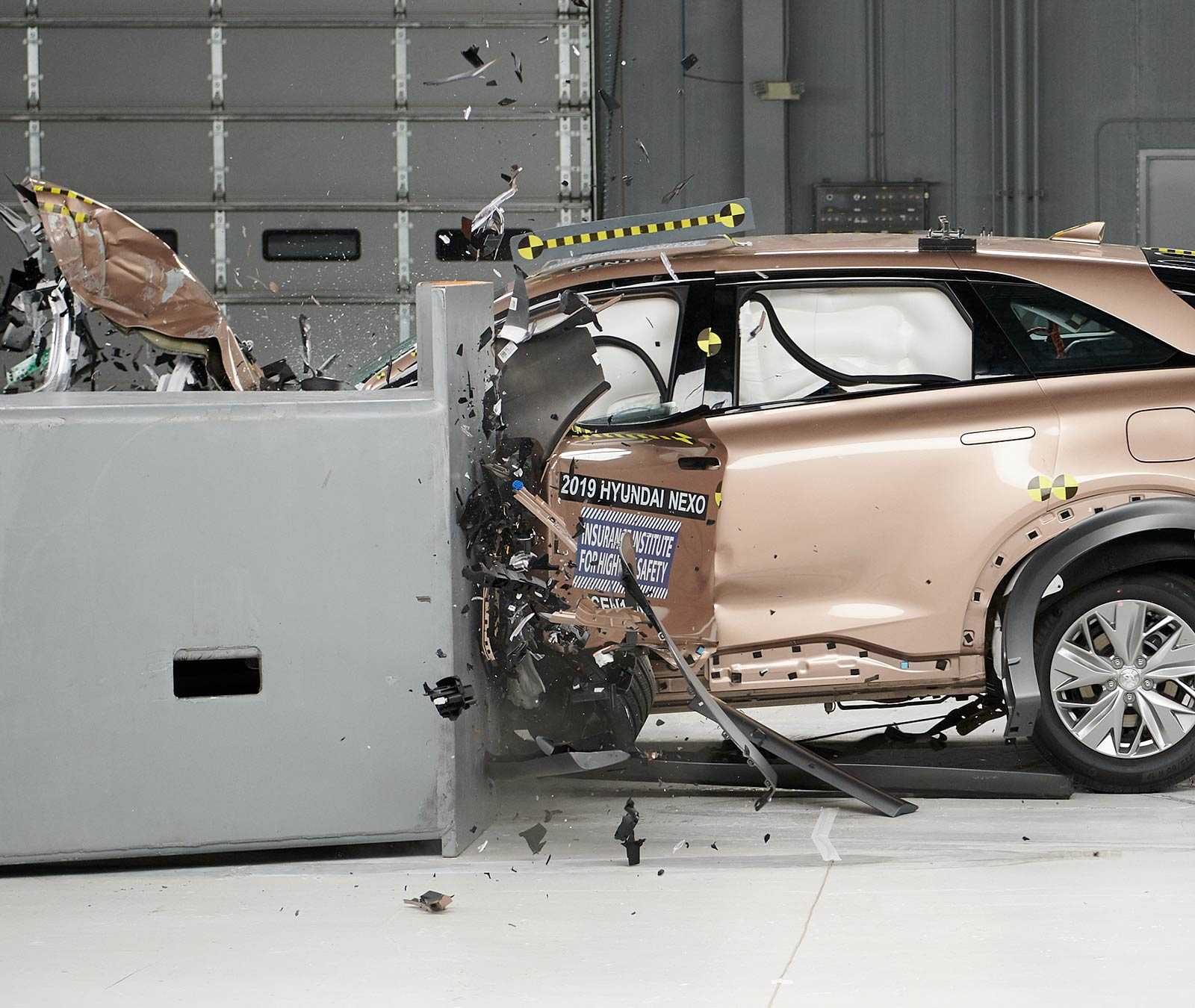
Action shot taken during the driver-side small overlap frontal crash test.
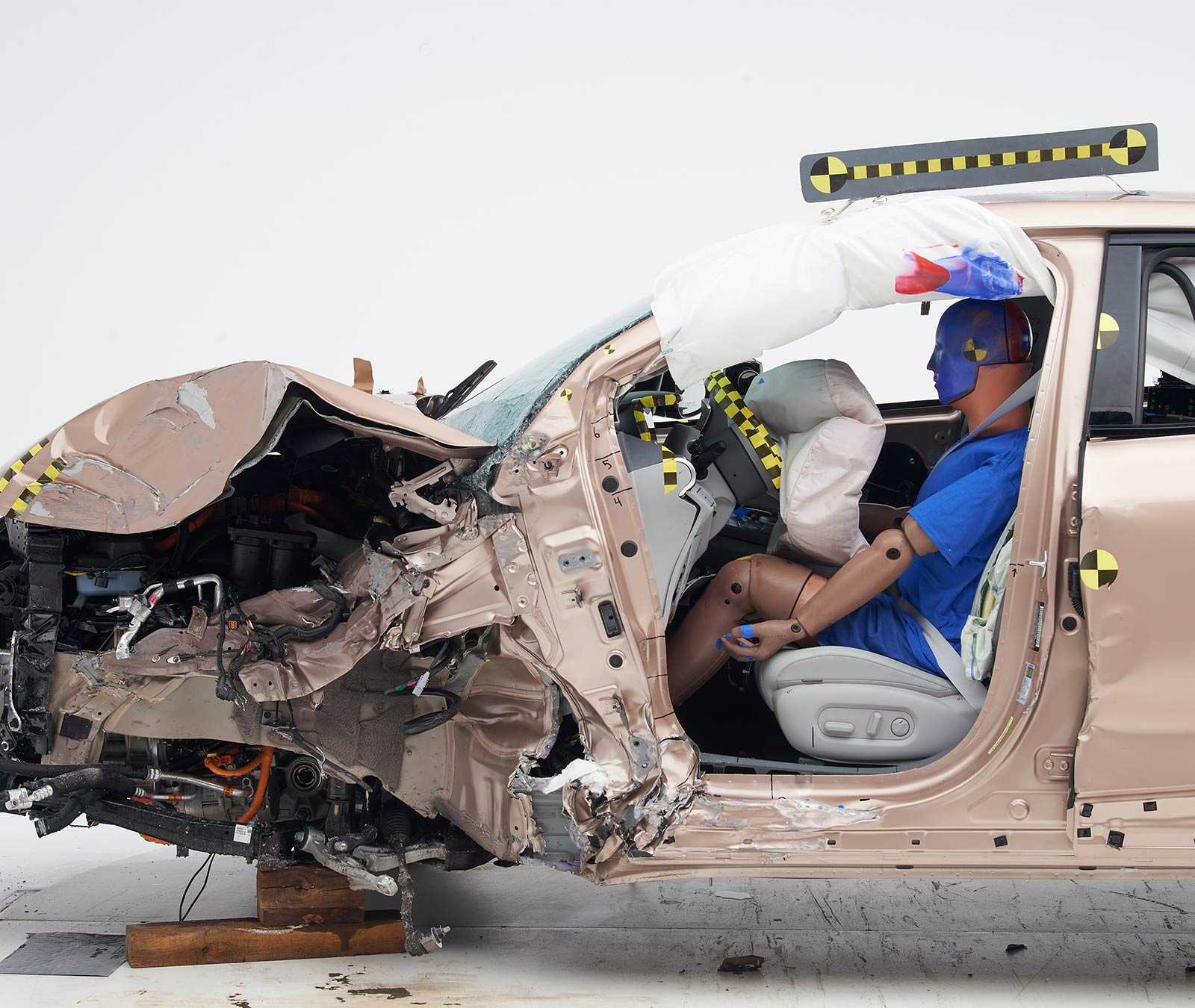
The dummy’s position in relation to the door frame, steering wheel, and instrument panel after the crash test indicates that the driver’s survival space was maintained reasonably well.
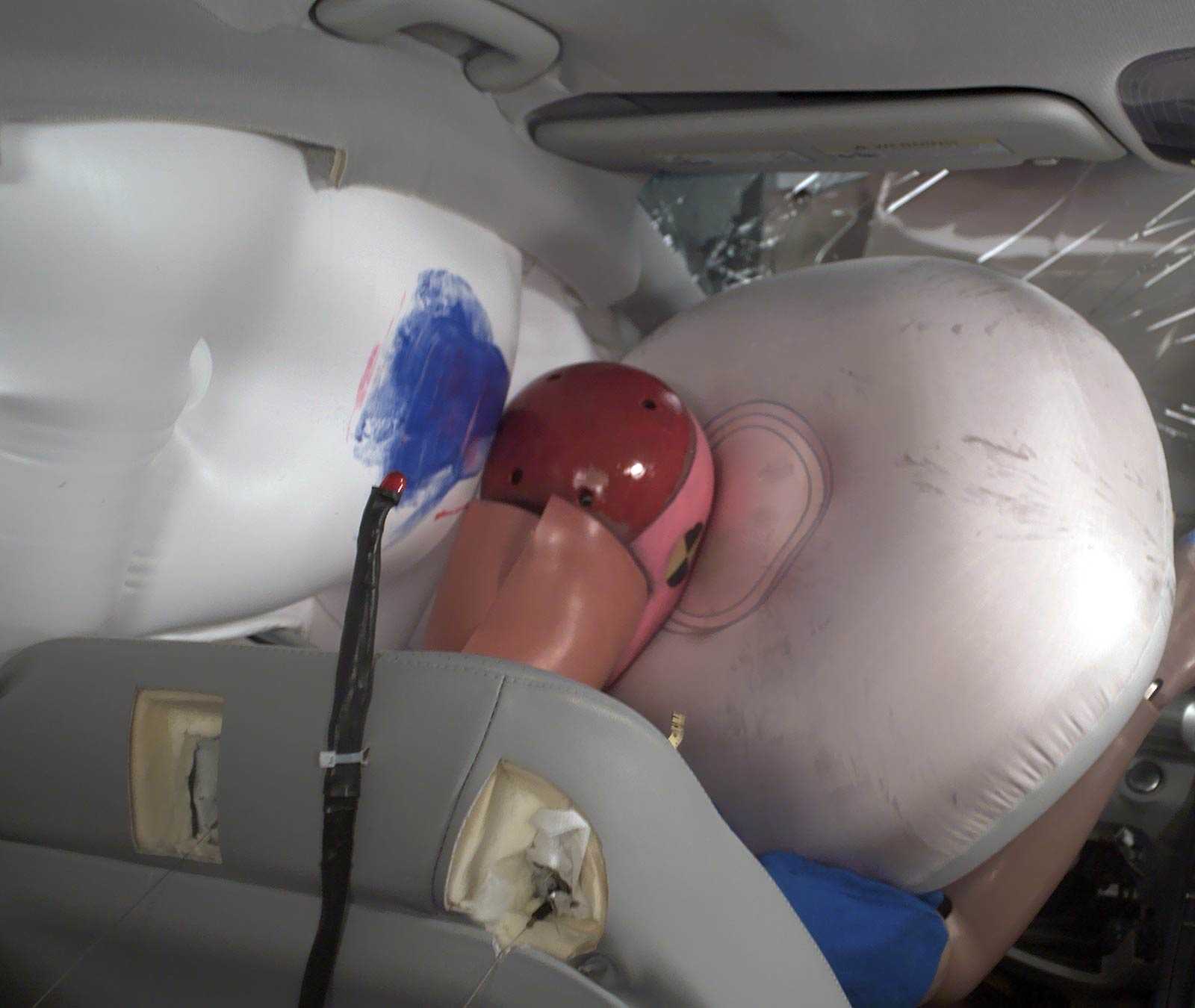
The frontal and side curtain airbags worked well together to keep the head from coming close to any stiff structure or outside objects that could cause injury.
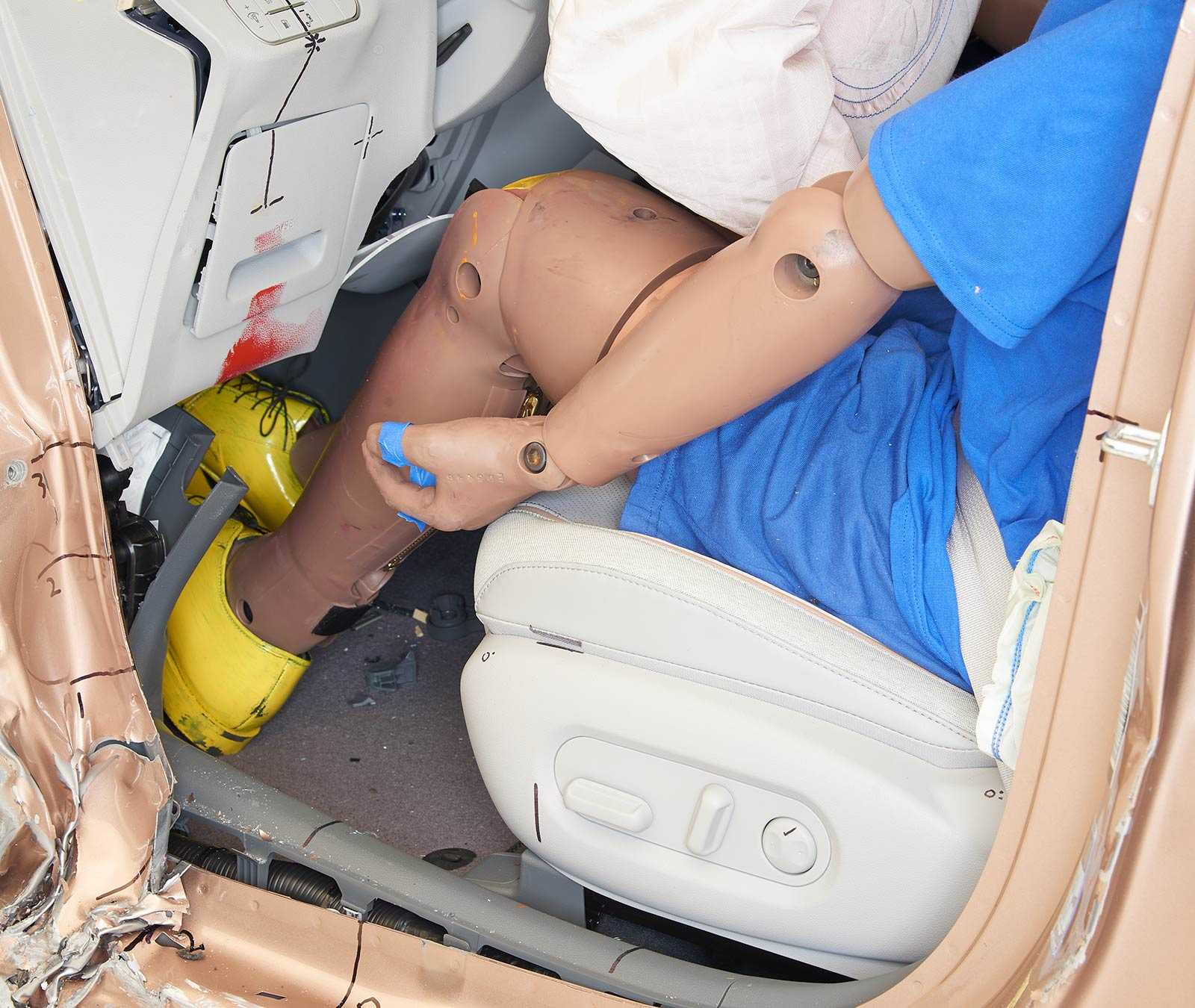
Intrusion of the door hinge pillar and instrument panel contributed to a moderate risk of injury to the left lower leg.
Technical measurements for this test
Measures of occupant compartment intrusion on driver side
| Test ID | CEN1904 |
|---|---|
| Lower occupant compartment | |
| Lower hinge pillar max (cm) | 18 |
| Footrest (cm) | 9 |
| Left toepan (cm) | 5 |
| Brake pedal (cm) | 3 |
| Parking brake (cm) | |
| Rocker panel lateral average (cm) | 4 |
| Upper occupant compartment | |
| Steering column | |
| Upper hinge pillar max (cm) | 8 |
| Upper dash (cm) | 12 |
| Lower instrument panel (cm) | 13 |
Driver injury measures
| Test ID | CEN1904 |
|---|---|
| Head | |
| HIC-15 | 94 |
| Peak gs at hard contact | no contact |
| Neck | |
| Tension (kN) | 0.8 |
| Extension bending moment (Nm) | 12 |
| Maximum Nij | 0.17 |
| Chest maximum compression (mm) | 24 |
| Femur (kN) | |
| Left | 0.7 |
| Right | 0.1 |
| Knee displacement (mm) | |
| Left | 3 |
| Right | |
| Knee-thigh-hip injury risk (%) | |
| Left | |
| Right | |
| Maximum tibia index | |
| Left | 0.98 |
| Right | 0.51 |
| Tibia axial force (kN) | |
| Left | 2.8 |
| Right | 0.2 |
| Foot acceleration (g) | |
| Left | 125 |
| Right | 39 |
Side: original test
Rating applies to 2019-22 models
Tested vehicle: 2019 Hyundai Nexo Fuel Cell Blue 4-door 2wd
The Hyundai Nexo was introduced in the 2019 model year. This SUV is based on the Tucson, but is a hydrogen-run fuel cell vehicle. Power comes from an electric motor.
| Overall evaluation | G |
|---|---|
| Structure and safety cage | G |
| Driver injury measures | |
| Head/neck | G |
| Torso | G |
| Pelvis/leg | G |
| Driver head protection | G |
| Rear passenger injury measures | |
| Head/neck | G |
| Torso | G |
| Pelvis/leg | G |
| Rear passenger head protection | G |
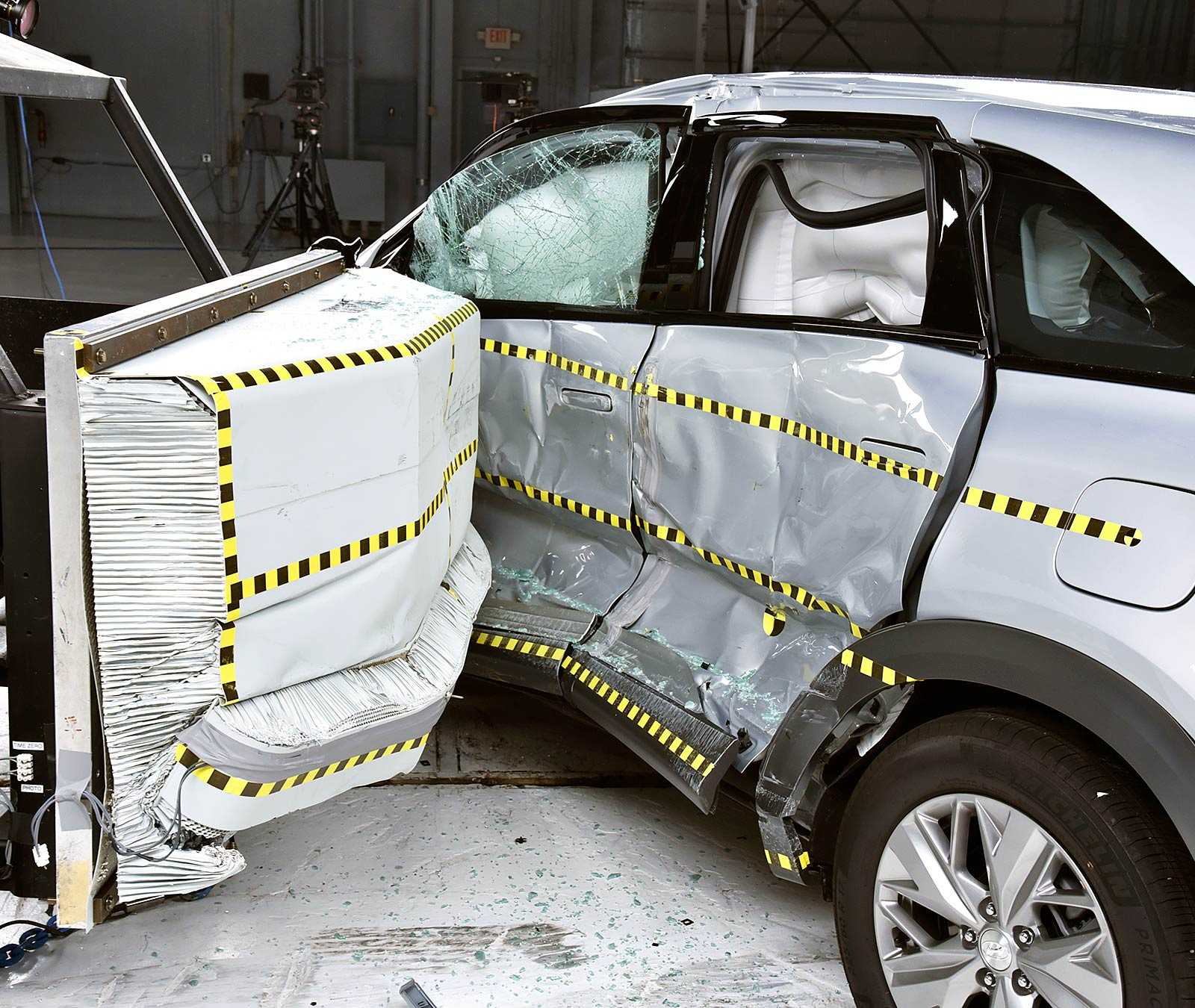
View of the vehicle and barrier just after the crash test.
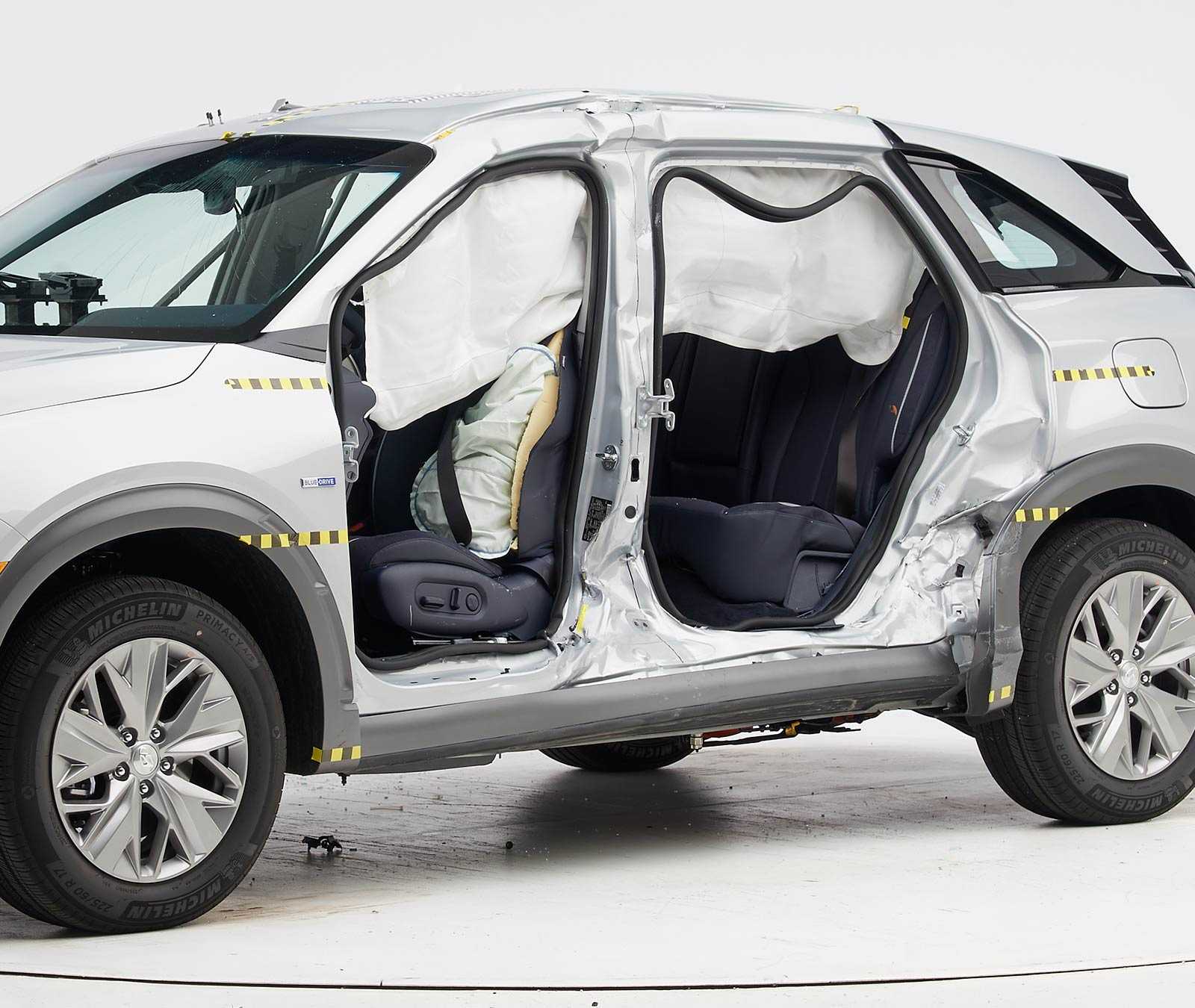
View of the vehicle after the crash with doors removed, showing the side airbags and damage to the occupant compartment.
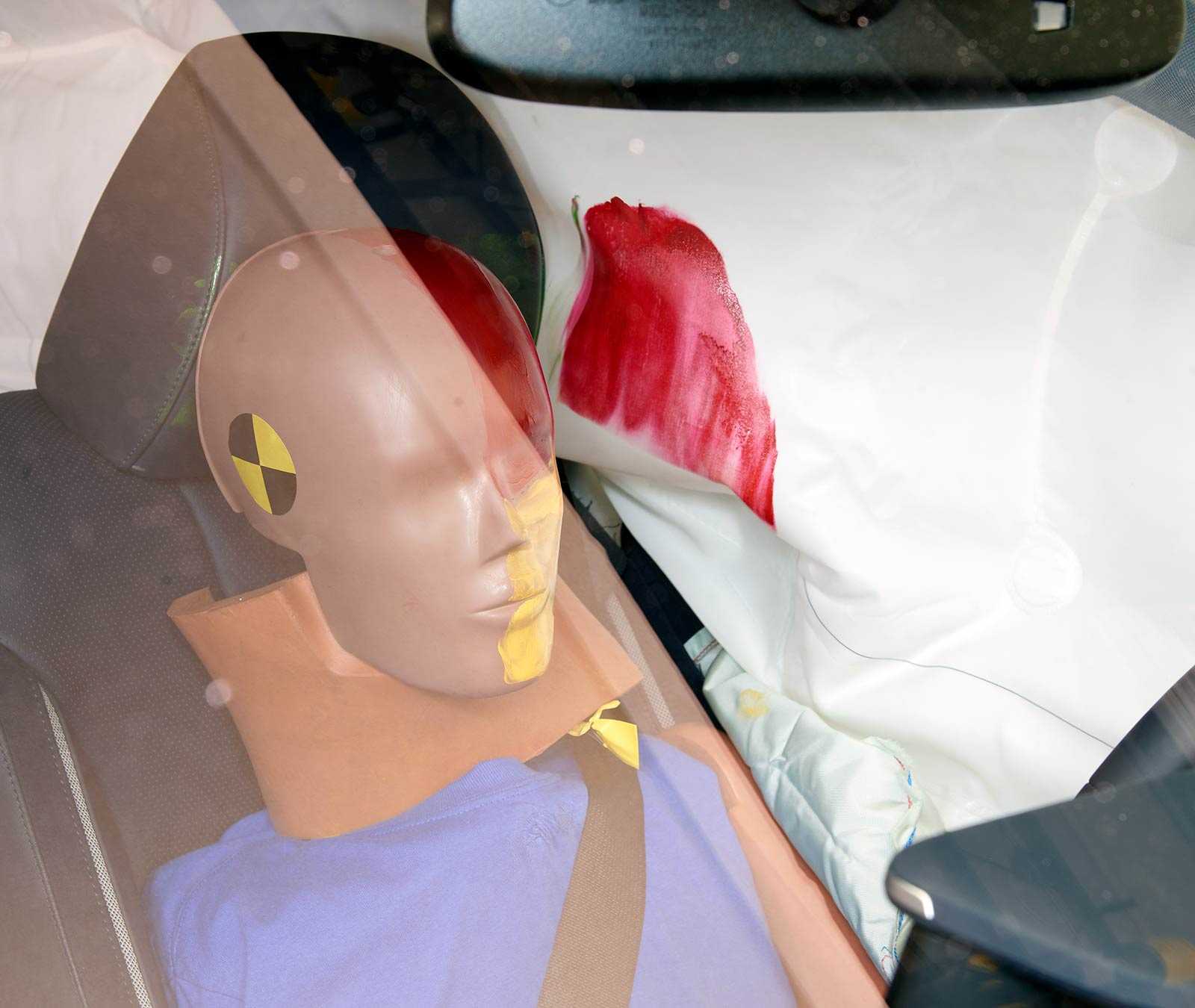
Smeared greasepaint shows where the driver dummy’s head was protected from being hit by hard structures by the side airbags.
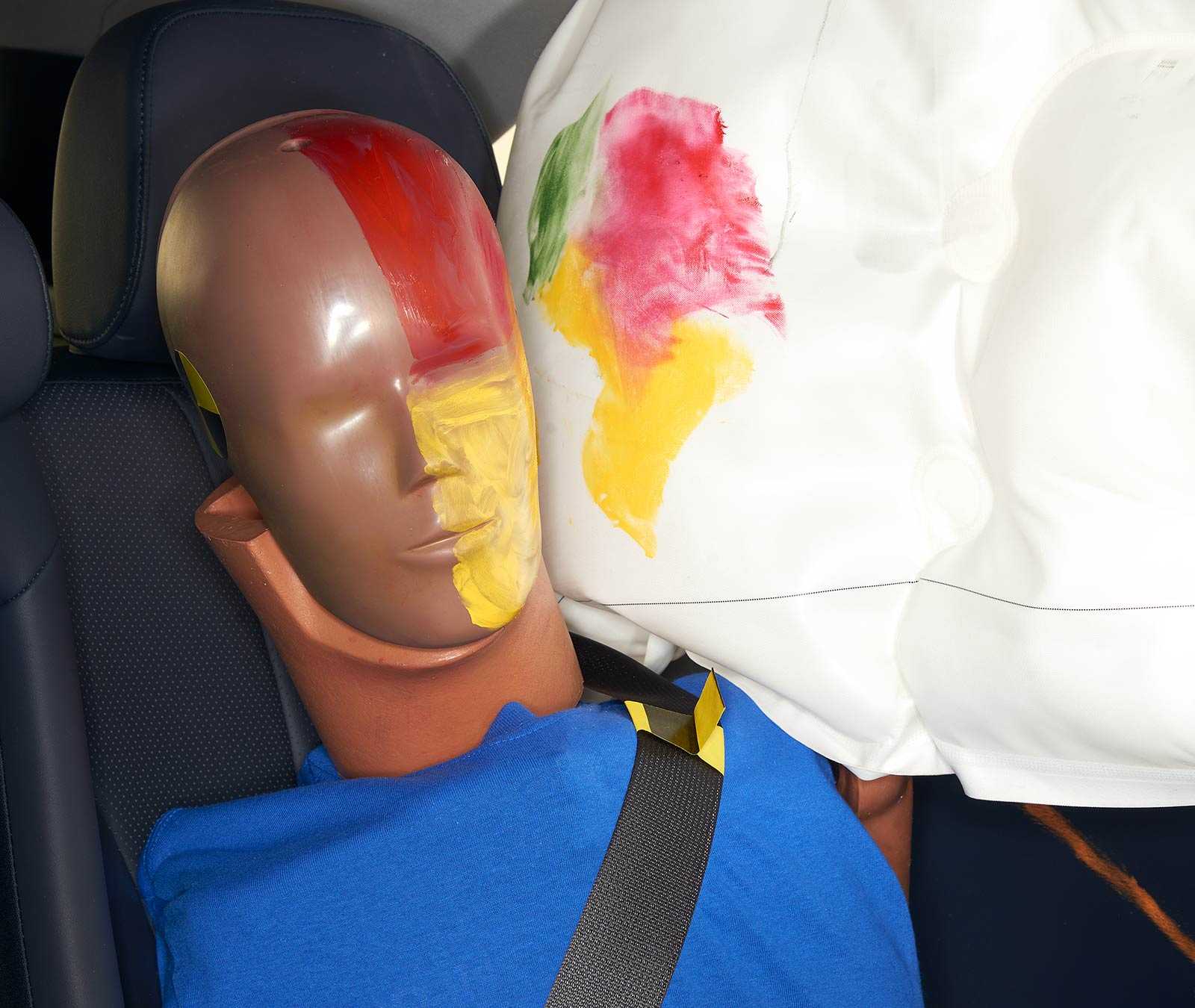
Smeared greasepaint shows where the rear passenger dummy’s head was protected by the side airbag.
Technical measurements for this test
Measures of occupant compartment intrusion on driver side
| Test ID | CES1904 |
|---|---|
| B-pillar to longitudinal centerline of driver’s seat (cm) | -16.5 |
| Negative numbers indicate the amount by which the crush stopped short of the seat centerline. |
Driver injury measures
| Test ID | CES1904 |
|---|---|
| Head HIC-15 | 214 |
| Neck | |
| Tension (kN) | 0.8 |
| Compression (kN) | 0.8 |
| Shoulder | |
| Lateral deflection (mm) | 35 |
| Lateral force (kN) | 1.7 |
| Torso | |
| Maximum deflection (mm) | 36 |
| Average deflection (mm) | 32 |
| Maximum deflection rate (m/s) | 4.63 |
| Maximum viscous criterion (m/s) | 0.42 |
| Pelvis | |
| Iliac force (kN) | 2.6 |
| Acetabulum force (kN) | 1.4 |
| Combined force (kN) | 3.9 |
| Left femur | |
| L-M force (kN) | 0.1 |
| L-M moment (Nm) | 83 |
| A-P moment (Nm) | -17 |
Passenger injury measures
| Test ID | CES1904 |
|---|---|
| Head HIC-15 | 97 |
| Neck | |
| Tension (kN) | 0.2 |
| Compression (kN) | 0.7 |
| Shoulder | |
| Lateral deflection (mm) | 40 |
| Lateral force (kN) | 1.8 |
| Torso | |
| Maximum deflection (mm) | 42 |
| Average deflection (mm) | 32 |
| Maximum deflection rate (m/s) | 4.63 |
| Maximum viscous criterion (m/s) | 0.66 |
| Pelvis | |
| Iliac force (kN) | 0.1 |
| Acetabulum force (kN) | 2.0 |
| Combined force (kN) | 2.0 |
| Left femur | |
| L-M force (kN) | 1.4 |
| L-M moment (Nm) | 187 |
| A-P moment (Nm) | -43 |
Small overlap front: passenger-side
Rating applies to 2019-22 models
Tested vehicle: 2019 Hyundai Nexo Fuel Cell Limited 4-door 2wd
The Hyundai Nexo was introduced in the 2019 model year. This SUV is based on the Tucson, but is a hydrogen-run fuel cell vehicle. Power comes from an electric motor. Passenger-side small overlap frontal ratings are assigned by the Institute based a test conducted by Hyundai as part of .
| Overall evaluation | G |
|---|---|
| Structure and safety cage | G |
| Passenger injury measures | |
| Head/neck | G |
| Chest | G |
| Hip/thigh | G |
| Lower leg/foot | G |
| Passenger restraints and dummy kinematics The dummy’s head contacted the frontal airbag but began to slide off toward the right side, leaving the head vulnerable to contact with forward structure. The side curtain airbag deployed and has sufficient forward coverage to protect the head from contact with side structure and outside objects. The side torso airbag also deployed. | A |
| Driver injury measures | |
| Head/neck | G |
| Chest | G |
| Hip/thigh | G |
| Lower leg/foot | G |
| Driver restraints and dummy kinematics | G |
Technical measurements for this test
Measures of occupant compartment intrusion on passenger side
| Test ID | VTP1919 |
|---|---|
| Lower occupant compartment | |
| Lower hinge pillar max (cm) | 11 |
| Footrest (cm) | 11 |
| Right toepan (cm) | 7 |
| Center toepan (cm) | 4 |
| Rocker panel lateral average (cm) | 3 |
| Upper occupant compartment | |
| Center dash (cm) | 2 |
| Upper hinge pillar max (cm) | 5 |
| Upper dash (cm) | 7 |
| Right lower dash (cm) | 8 |
Passenger injury measures
| Test ID | VTP1919 |
|---|---|
| Head | |
| HIC-15 | 144 |
| Peak gs at hard contact | no contact |
| Neck | |
| Tension (kN) | 0.9 |
| Extension bending moment (Nm) | 12 |
| Maximum Nij | 0.16 |
| Chest maximum compression (mm) | 22 |
| Femur (kN) | |
| Left | 0.5 |
| Right | 0.6 |
| Knee displacement (mm) | |
| Left | 4 |
| Right | 4 |
| Knee-thigh-hip injury risk (%) | |
| Left | |
| Right | |
| Maximum tibia index | |
| Left | 0.49 |
| Right | 0.43 |
| Tibia axial force (kN) | |
| Left | 0.9 |
| Right | 1.0 |
| Foot acceleration (g) | |
| Left | 40 |
| Right | 38 |
Driver injury measures
| Test ID | VTP1919 |
|---|---|
| Head | |
| HIC-15 | 71 |
| Peak gs at hard contact | no contact |
| Neck | |
| Tension (kN) | 0.9 |
| Extension bending moment (Nm) | 10 |
| Maximum Nij | 0.18 |
| Chest maximum compression (mm) | 24 |
| Femur (kN) | |
| Left | 0.2 |
| Right | 0.2 |
| Knee displacement (mm) | |
| Left | 1 |
| Right | |
| Knee-thigh-hip injury risk (%) | |
| Left | |
| Right | |
| Maximum tibia index | |
| Left | 0.27 |
| Right | 0.18 |
| Tibia axial force (kN) | |
| Left | 0.4 |
| Right | 0.6 |
| Foot acceleration (g) | |
| Left | 43 |
| Right | 31 |
Headlights
Ratings are given for 2 different headlight variations available on this vehicle.
Trim level(s)
-
Blue trim; built after June 2019
-
Limited trim; built after June 2019
| Low-beam headlight type | LED projector |
|---|---|
| High-beam headlight type | LED projector |
| Curve-adaptive? | No |
| High-beam assist? | Yes |
| Overall rating | G |
| Distance at which headlights provide at least 5 lux illumination: |
car-simplercar-simplercar-simplercar-simplercar-simpler0 ft100 ft200 ft300 ft400 ft500 ft600 ftLow beamsOptimal low-beamilluminationHigh beamsOptimal high-beamilluminationHigh-beam assist credit
Low beams On the straightaway, visibility was good on both sides of the road. On curves, visibility was good on the gradual right and gradual left curves and fair on the sharp right and sharp left curves.
The low beams never exceeded glare limits.
High beams On the straightaway, visibility was good on both sides of the road. On curves, visibility was fair on the gradual right and gradual left curves and inadequate on the sharp right and sharp left curves.
High-beam assist compensates for some limitations of this vehicle’s low beams on both left curves and on the sharp right curve.
Technical measurements for this test
| Trim level(s) |
|
|---|---|
| Low-beam headlight type | LED projector |
| High-beam headlight type | LED projector |
| Curve-adaptive? | No |
| High-beam assist? | Yes |
| Overall ratingApplies to 2019-22 models built after June 2019 | G |
| LOW BEAMS | Average minimum useful illumination distance (5 lux) | Amount glare exceeded threshold |
|---|---|---|
| Straightaway right edge | 130.9 m | None |
| Straightaway left edge | 67.5 m | None |
| 250m radius right curve, right edge | 68.4 m | None |
| 250m radius left curve, left edge | 65.8 m | None |
| 150m radius right curve, right edge | 51.3 m | None |
| 150m radius left curve, left edge | 49.3 m | None |
| HIGH BEAMS | Average minimum useful illumination distance (5 lux) |
|---|---|
| Straightaway right edge | 165.2 m |
| Straightaway left edge | 148.7 m |
| 250m radius right curve, right edge | 68.3 m |
| 250m radius left curve, left edge | 67.2 m |
| 150m radius right curve, right edge | 51.5 m |
| 150m radius left curve, left edge | 50.2 m |
Trim level(s)
-
Blue trim; built before July 2019
-
Limited trim; built before July 2019
| Low-beam headlight type | LED projector |
|---|---|
| High-beam headlight type | LED projector |
| Curve-adaptive? | No |
| High-beam assist? | Yes |
| Overall rating | A |
| Distance at which headlights provide at least 5 lux illumination: |
car-simplercar-simplercar-simplercar-simplercar-simpler0 ft100 ft200 ft300 ft400 ft500 ft600 ftLow beamsOptimal low-beamilluminationHigh beamsOptimal high-beamilluminationHigh-beam assist credit
Low beams On the straightaway, visibility was good on the left side of the road and inadequate on the right side. On curves, visibility was fair on both right curves and inadequate on both left curves.
The low beams never exceeded glare limits.
High beams On the straightaway, visibility was good on the right side of the road and fair on the left side. On curves, visibility was fair on the gradual right curve and inadequate on the sharp right and both left curves.
High-beam assist compensates for some limitations of this vehicle’s low beams on the straightaway and all 4 curves.
Technical measurements for this test
| Trim level(s) |
|
|---|---|
| Low-beam headlight type | LED projector |
| High-beam headlight type | LED projector |
| Curve-adaptive? | No |
| High-beam assist? | Yes |
| Overall ratingApplies to 2019 models built before July 2019 | A |
| LOW BEAMS | Average minimum useful illumination distance (5 lux) | Amount glare exceeded threshold |
|---|---|---|
| Straightaway right edge | 70.9 m | None |
| Straightaway left edge | 55.1 m | None |
| 250m radius right curve, right edge | 64.0 m | None |
| 250m radius left curve, right edge | 49.0 m | None |
| 150m radius right curve, right edge | 51.2 m | None |
| 150m radius left curve, left edge | 44.4 m | None |
| HIGH BEAMS | Average minimum useful illumination distance (5 lux) |
|---|---|
| Straightaway right edge | 164.9 m |
| Straightaway left edge | 138.1 m |
| 250m radius right curve, right edge | 68.9 m |
| 250m radius left curve, left edge | 63.8 m |
| 150m radius right curve, right edge | 51.5 m |
| 150m radius left curve, left edge | 47.5 m |
Hyundai Nexo — расслабленная поездка
Всего за несколько километров езды на Nexo становится ясно одно — этот автомобиль путешествует крайне расслабленно. Это потому, что машина очень хорошо звукозолирована. Нет шума или ветра вокруг кузова. Тщательно отрегулированная подвеска также способствует комфортному путешествию, которая не только работает тихо, но и хорошо подавляет любые неровности поверхности. О том, что дизайн транспортного средства был больше ориентирован на комфорт, чем на вождение, свидетельствует не только характеристики шасси, но и то, как работает система рулевого управления — его работа могла бы быть несколько более точной. Кроме того, вес автомобиля можно почувствовать при тестировании динамических поворотов.
Для привода Nexo предусмотрен электродвигатель мощностью 163 л.с. Благодаря этому автомобиль достигает сотни всего за 9,5 секунды. Также нет никаких оговорок в отношении эластичности, благодаря которой нет проблем с ускорением при обгоне.
Hyundai Nexo — дальние расстояния
Большинство водителей беспокоятся о дальнем путешествии на электромобиле. Это беспокойство связано с несколькими факторами. Во-первых, дальность, указанная в начале маршрута на более высоких скоростях, уменьшается непропорционально пройденным километрам. Второе — это время зарядки — у многих людей это занимает слишком много времени. Кроме того, вы всегда беспокоитесь о том, будет ли доступно зарядное устройство в указанном месте. Если нет, время остановки может быть значительно больше. Для водорода Nexo это не проблема. Во-первых, его теоретически дальность пробега на одной заправке составляет 666 км (согласно WLTP), а во-вторых, когда мы добираемся до станции, заправка занимает около 5 минут. Конечно, это с оговоркой, что поблизости от вас есть такие заправочные станции. Если говорить о Германии, то там к концу 2020 года должно быть построено 100 станций на которых можно будет заправлять автомобиль водородом.
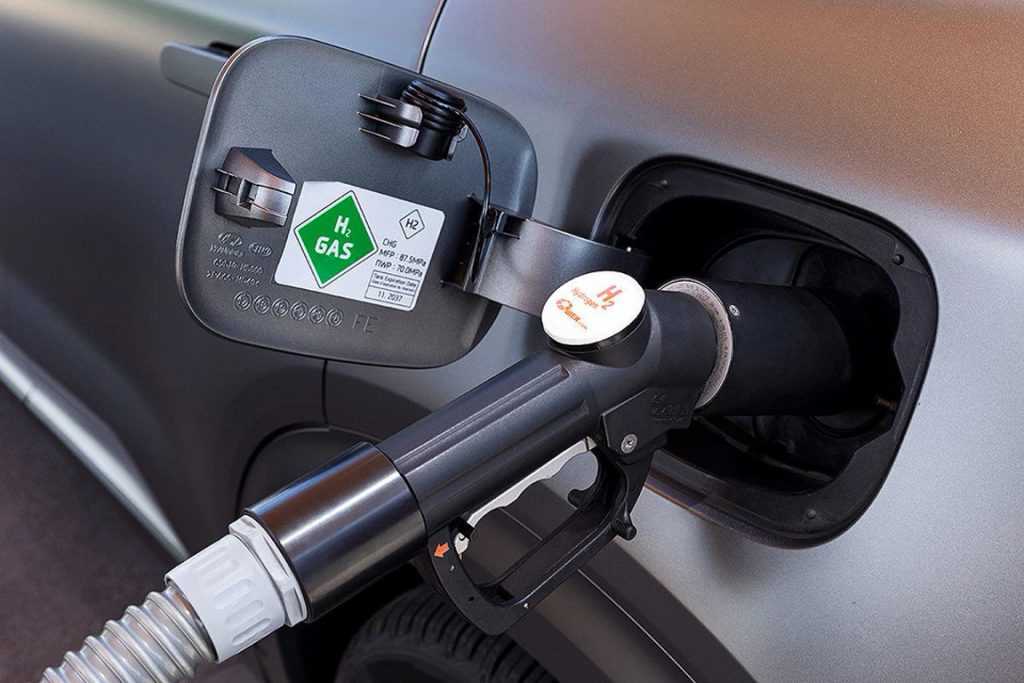
Первоначально производители автомобилей, которые пытались использовать подачу водорода, испытывали заправку жидким водородом. Жидкий газ нужно было подавать в резервуары при температуре ниже — 250 градусов — это было очень дорого и опасно. Тем временем было решено хранить водород в газообразной форме. В результате Nexo может хранить 6,33 кг водорода в трех резервуарах. Он вдавливается в них под давлением 700 бар. Чтобы выдержать это давление, резервуары должны иметь стенки толщиной 4,5 см!
Топливный насос на станции работает по тому же принципу, что и насос для автомобилей, работающих на природном газе. После подсоединения шланга к разъему в автомобиле и его блокировки давление уравнивается и начинается дозаправка. Кнопка «Пуск» информирует нас о завершении заправки. Все это очень легко, и только шипение и звук газа, подаваемого в резервуары, требуют привыкания.
Child seat anchors
Applies to 2019-22 models
| Overall evaluation |
G |
| Vehicle trim | Fuel Cell Blue |
| Seat type | leatherette |
This vehicle has 2 rear seating positions with complete child seat attachment (LATCH) hardware.
It has 1 additional seating position with a tether anchor only.
| Overall evaluation |
G |
| Vehicle trim | Fuel Cell Blue |
| Seat type | leatherette |
123
| G | Good |
| A | Acceptable |
| M | Marginal |
| P | Poor |
| Seating positions that rely on borrowed lower anchors or have only a tether anchor available are not rated. | |
| thether anchor symbol | Tether anchor |
| lower anchor symbol | Lower anchors |
| Lower anchor(s) can be borrowed from adjacent positions(s) | |
| No hardware available |
Details by seating position
| 1 | |
|---|---|
| Tether anchor | |
| easy-to-find location | |
| no other hardware could be confused for anchor | |
| Lower anchors | |
| not too deep in seat | |
| not too much force needed to attach | |
| easy to maneuver around anchors | |
| 2 | |
| Tether anchor | |
| easy-to-find location | |
| no other hardware could be confused for anchor | |
| Lower anchors | |
| none available | |
| 3 | |
| Tether anchor | |
| easy-to-find location | |
| no other hardware could be confused for anchor | |
| Lower anchors | |
| not too deep in seat | |
| not too much force needed to attach | |
| easy to maneuver around anchors |
Technical measurements for this test
Seat position 21
3
| Lower anchor A | |
|---|---|
| Open access rated | No |
| Depth (cm) | 0-2 |
| Force (lbs) | 9 |
| Clearance angle (degrees) | 79 |
| Lower anchor B | |
| Open access rated | No |
| Depth (cm) | 0-2 |
| Force (lbs) | 8 |
| Clearance angle (degrees) | 79 |
| Tether anchor | |
| Location | Middle seatback |
| Confusing hardware present | Yes |
| Has contrasting label within 3 inches of tether anchor | Yes |
Seat position 22
2
| Lower anchor A | |
|---|---|
| No lower latch for this seat position | |
| Lower anchor B | |
| No lower latch for this seat position | |
| Tether anchor | |
| Location | Middle seatback |
| Confusing hardware present | Yes |
| Has contrasting label within 3 inches of tether anchor | Yes |
Seat position 23
1
| Lower anchor A | |
|---|---|
| Open access rated | No |
| Depth (cm) | 0-2 |
| Force (lbs) | 12 |
| Clearance angle (degrees) | 78 |
| Lower anchor B | |
| Open access rated | No |
| Depth (cm) | 0-2 |
| Force (lbs) | 15 |
| Clearance angle (degrees) | 76 |
| Tether anchor | |
| Location | Middle seatback |
| Confusing hardware present | Yes |
| Has contrasting label within 3 inches of tether anchor | Yes |
Бортовая электростанция
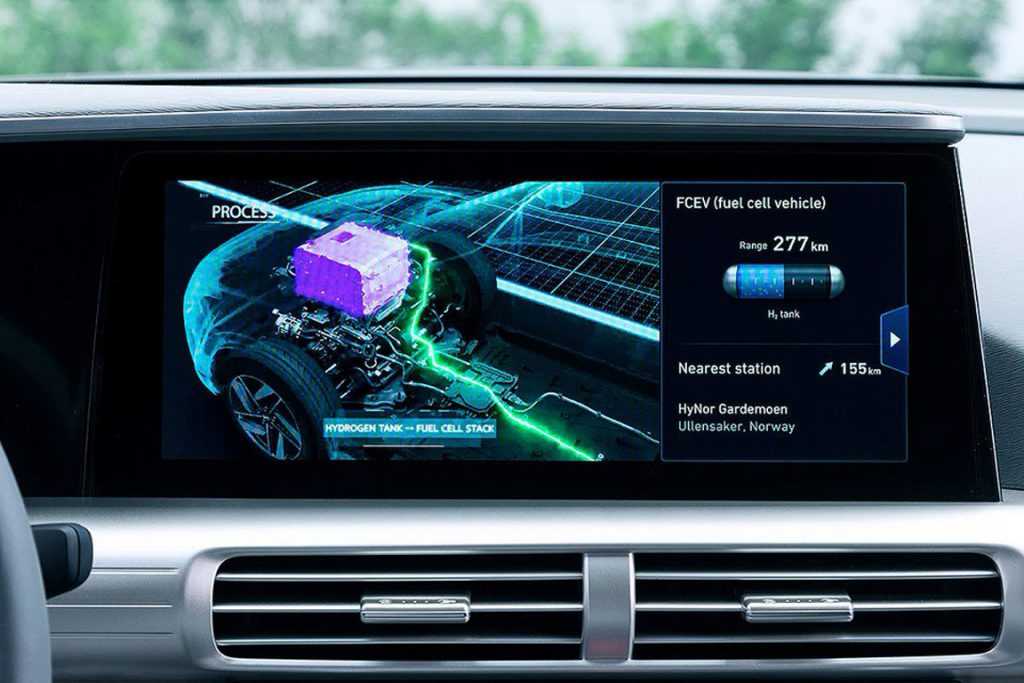 Тест драйв Hyundai Nexo
Тест драйв Hyundai Nexo
Традиционный электрический автомобиль получает энергию, необходимую для вождения от аккумуляторов, установленных на борту. Между тем, водородный автомобиль сам производит энергию, необходимую ему для путешествий. Итак, вы путешествуете на частной электростанции. Водород, накопленный в трех резервуарах высокого давления, подается в топливные элементы.
Система состоит из двух разделенных областей. В анодной части водород просто делится на ионы водорода и электроны. Ионы протекают через сепаратор в катод, где они соединяются с кислородом, образуя воду. Электроны также хотят перейти на другую сторону катода, но они не могут пройти через сепаратор. Поэтому они должны перемещаться вокруг соответствующего провода к электродвигателю. С другой стороны электрическая система закрыта.
Во время динамического ускорения требуется большая доза тока. Его излишки, полученные рекуперацией во время торможения, накапливаются в батарее, расположенной на борту автомобиля.
Moderate overlap front: original test
Rating applies to 2019-22 models
Tested vehicle: 2019 Hyundai Nexo Fuel Cell Blue 4-door 2wd
The Hyundai Nexo was introduced in the 2019 model year. This SUV is based on the Tucson, but is a hydrogen-run fuel cell vehicle. Power comes from an electric motor.
| Overall evaluation | G |
|---|---|
| Structure and safety cage | G |
| Driver injury measures | |
| Head/neck | G |
| Chest | G |
| Leg/foot, left | G |
| Leg/foot, right | G |
| Driver restraints and dummy kinematics | G |
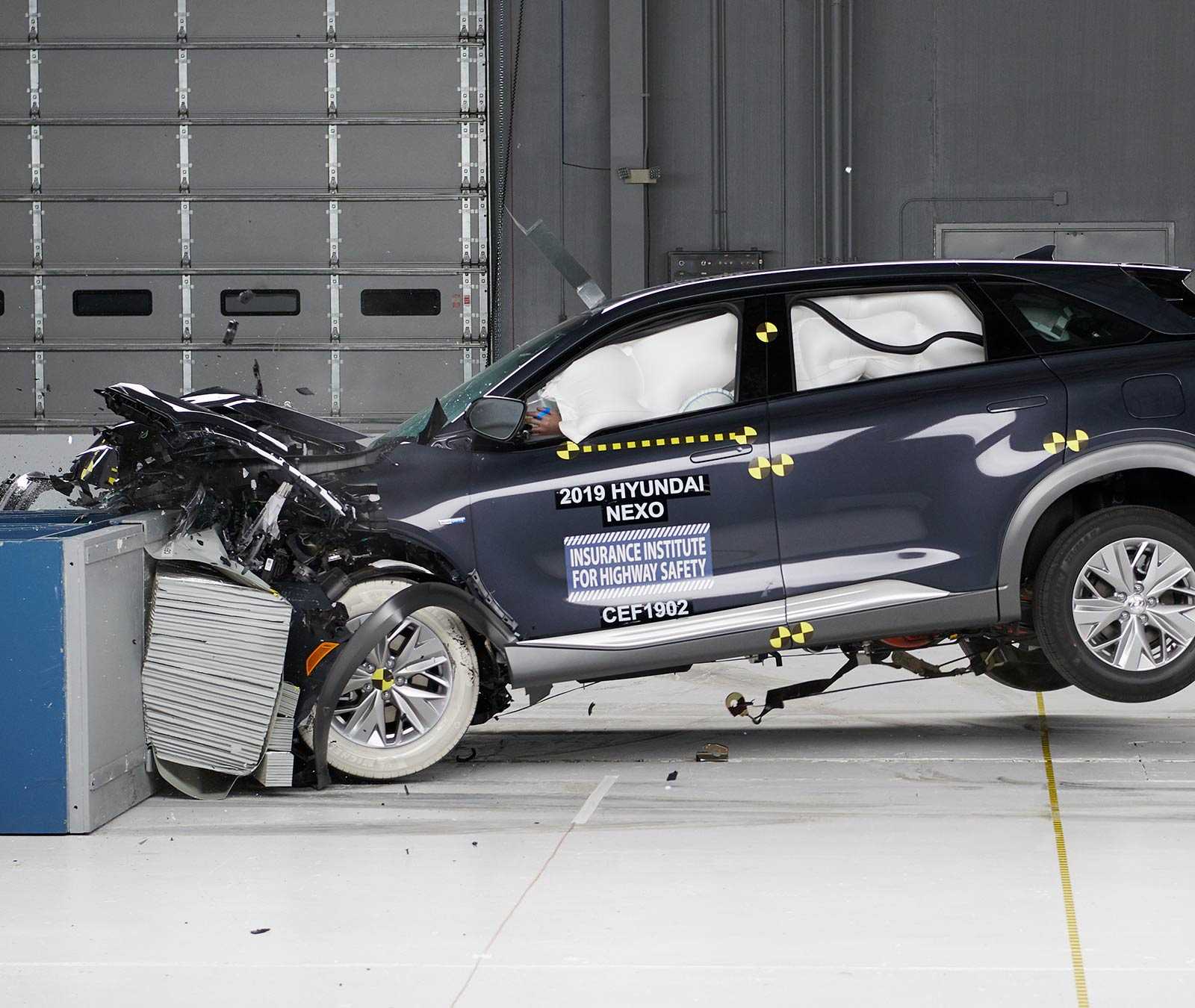
Action shot taken during the moderate overlap frontal crash test.
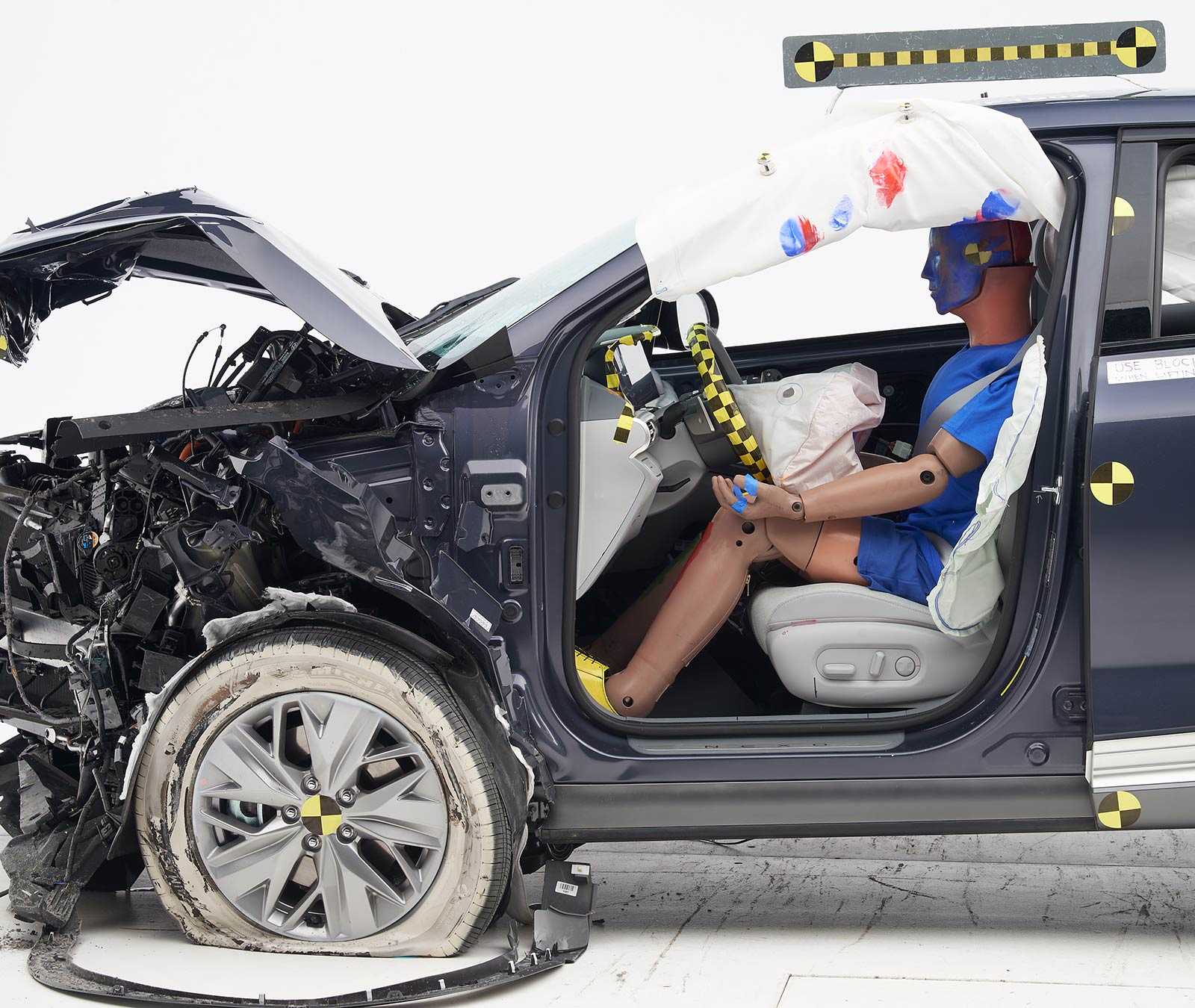
The dummy’s position in relation to the steering wheel and instrument panel after the crash test indicates that the driver’s survival space was maintained well.
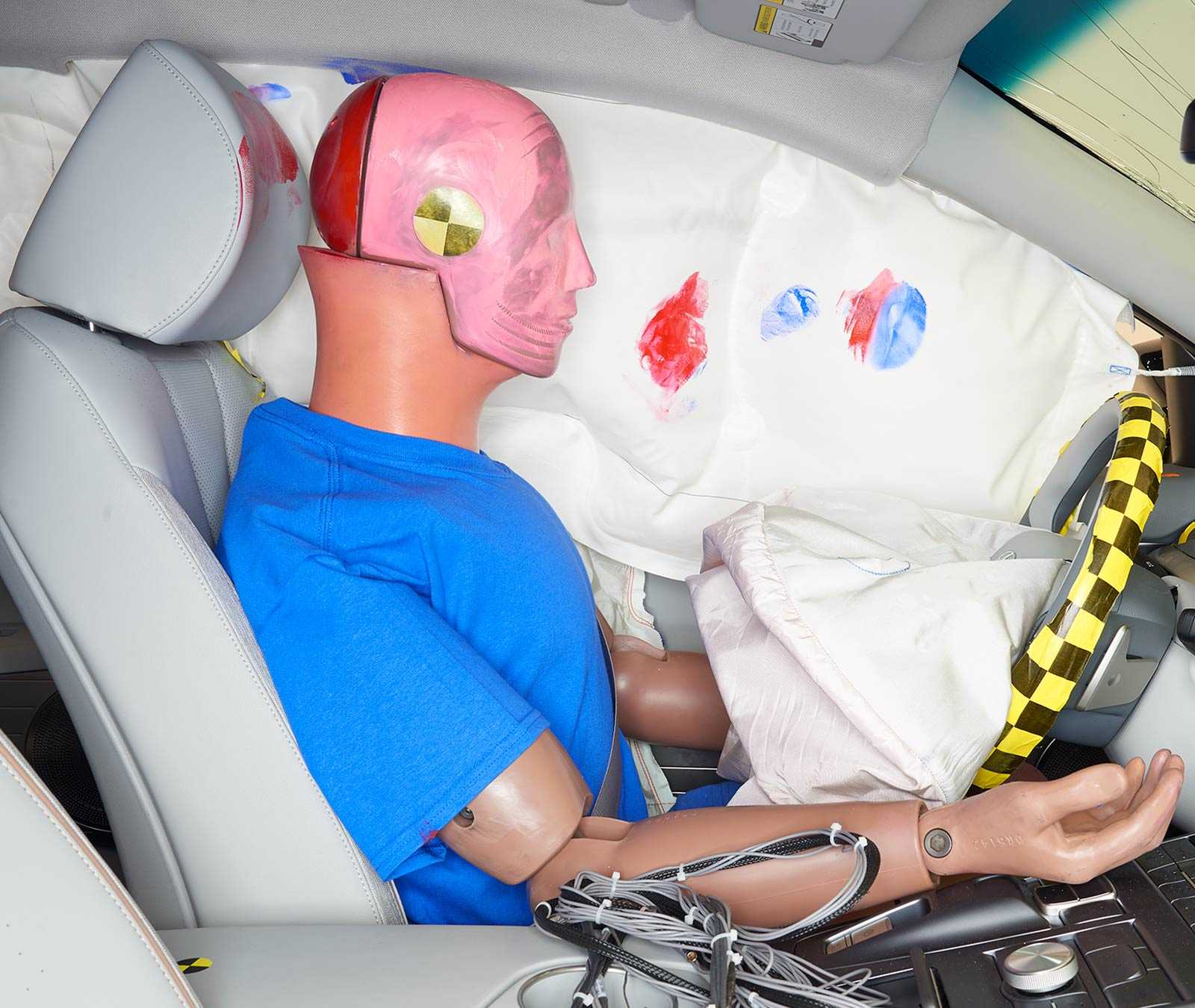
Smeared greasepaint indicates where the dummy’s head contacted the side curtain airbag during both forward excursion and rebound.
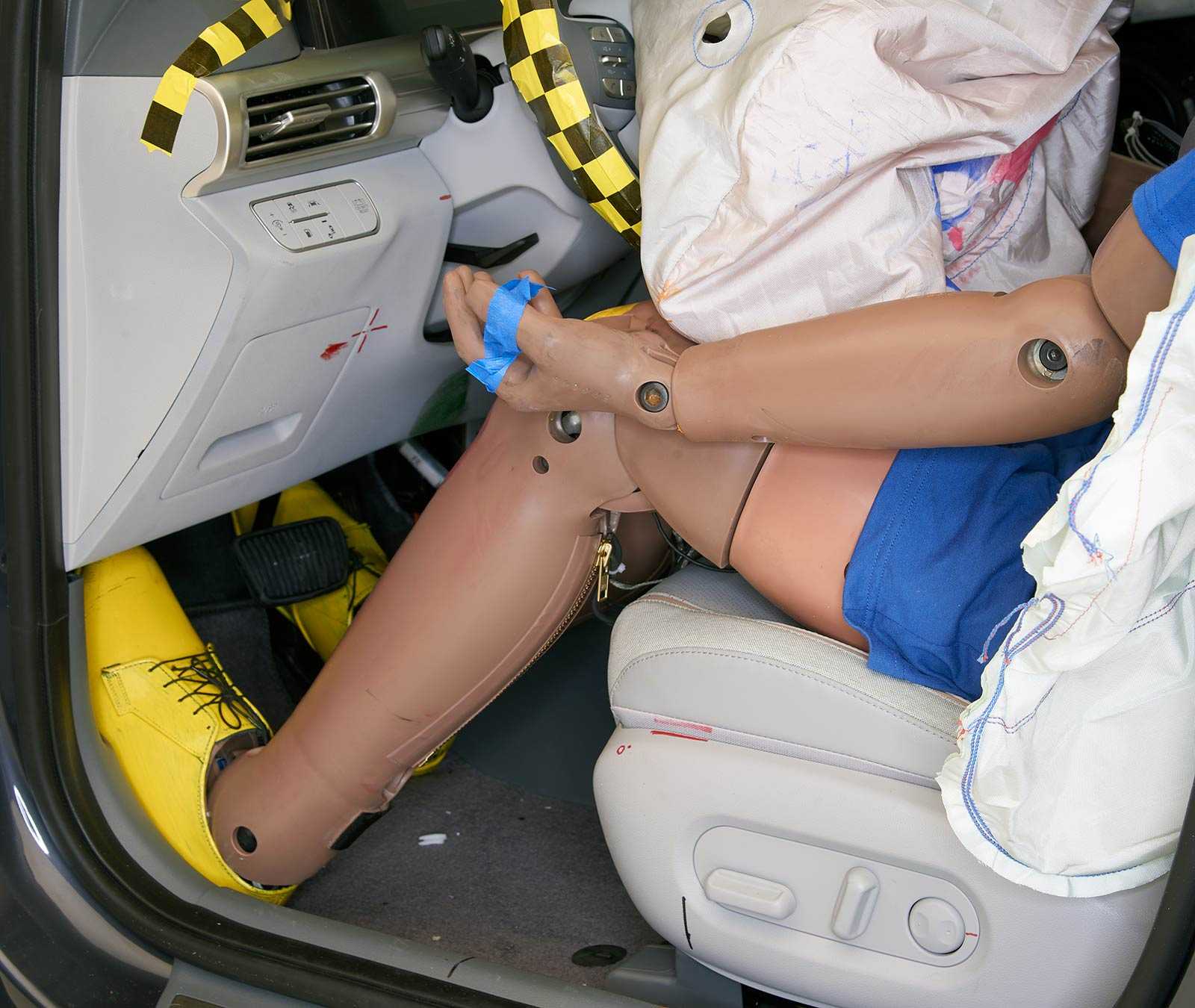
Intrusion into the driver’s space was minimal, and all leg and foot injury measures were low.
Technical measurements for this test
Measures of occupant compartment intrusion on driver side
| Test ID | CEF1902 |
|---|---|
| Footwell intrusion | |
| Footrest (cm) | 4 |
| Left (cm) | 7 |
| Center (cm) | 10 |
| Right (cm) | 10 |
| Brake pedal (cm) | 8 |
| Instrument panel rearward movement | |
| Left (cm) | 1 |
| Right (cm) | 2 |
| Steering column movement | |
| Upward (cm) | -2 |
| Rearward (cm) | -2 |
| A-pillar rearward movement (cm) |
Driver injury measures
| Test ID | CEF1902 |
|---|---|
| Head | |
| HIC-15 | 226 |
| Peak gs at hard contact | no contact |
| Neck | |
| Tension (kN) | 1.0 |
| Extension bending moment (Nm) | 15 |
| Maximum Nij | 0.23 |
| Chest maximum compression (mm) | 28 |
| Legs | |
| Femur force — left (kN) | 0.2 |
| Femur force — right (kN) | 0.2 |
| Knee displacement — left (mm) | |
| Knee displacement — right (mm) | |
| Maximum tibia index — left | 0.36 |
| Maximum tibia index — right | 0.70 |
| Tibia axial force — left (kN) | 1.7 |
| Tibia axial force — right (kN) | 1.3 |
| Foot acceleration (g) | |
| Left | 42 |
| Right | 54 |






























